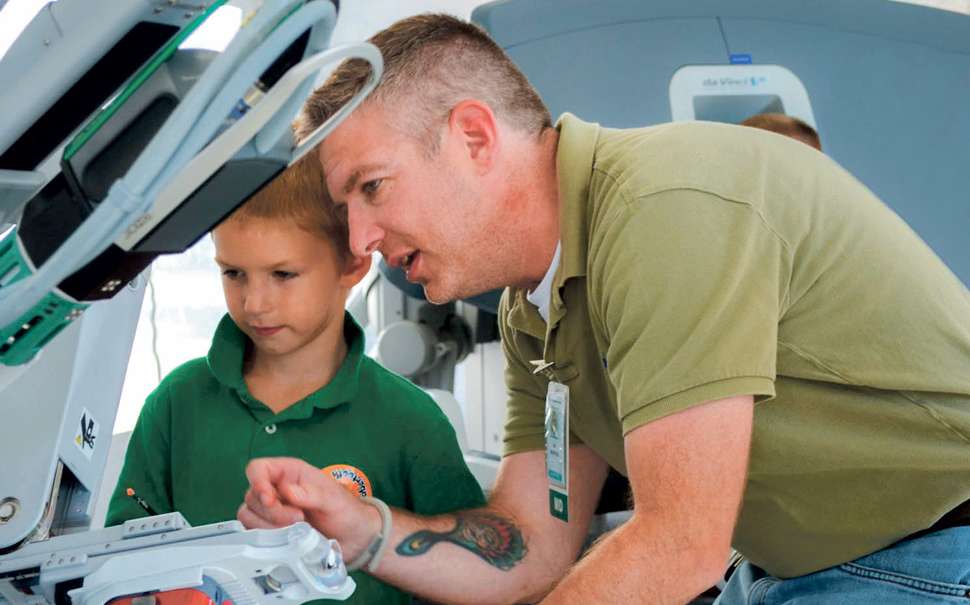
Robots at the bedside: Hospitals are using more of them, but how far will the trend go?
 Photo / Courtesy of MaineGeneral
At right are the robotic arms of the da Vinci robot that is at the Thayer Center for Health in Waterville. Dr. Ian Reight sits at the control console in the back left. The monitor at left shows what Dr. Reight is seeing at the console. On the table is a game MaineGeneral uses to show the abilities of the robot to the public.
Photo / Courtesy of MaineGeneral
At right are the robotic arms of the da Vinci robot that is at the Thayer Center for Health in Waterville. Dr. Ian Reight sits at the control console in the back left. The monitor at left shows what Dr. Reight is seeing at the console. On the table is a game MaineGeneral uses to show the abilities of the robot to the public.
When Dr. Ian Reight arrived as a general surgeon at MaineGeneral Medical Center in Augusta, in 2012, he and his team began to explore the use of robotic surgery.
He counted himself among the critics. “I started to do robotic surgery to prove it wasn’t very good,” he says. “I wanted to prove that laparoscopy was better and faster. I was a big robotics naysayer.”
But the technology, relatively new at the time, got the upper hand.
“What happened to me was much like what happened to many surgeons throughout the U.S.,” he adds. “In learning to do it well, we proved it’s an incredibly valuable tool for minimally invasive surgery.”
Now Reight chairs the robotics surgery program. “Over the past six years, we have averaged a 22% increase annually,” he says. “We continue to look at ways to innovate. It’s better than open surgery and laparoscopic surgery in selected cases.”
Console control
Reight’s experience reflects a growing adoption throughout Maine of surgical robots.
The technology is an evolution of laparoscopic surgery. Both use tiny incisions, tiny video cameras and special surgical instruments. But surgical robots provide a computerized assist to laparoscopic procedures, using advanced instruments and a three-dimensional, high-definition view of the surgical area.
Some surgeons liken the technology to video games because it involves manipulating instruments from a control console rather than directly by hand. The use is still evolving and is seen as having great potential for additional applications as the hardware and software become increasingly refined and as surgeons innovate new uses.

Experts agree there are numerous benefits, including faster recovery time, fewer complications and fewer conversions to open surgery. That, in turn, potentially lowers patient and hospital costs.
One medical device company dominates the industry. Intuitive Surgical Inc. in Sunnyvale, Calif., launched the da Vinci surgical system in 1999. It’s produced several generations since then, according to its website.
The system consists of several components. A surgeon sits at a console, or control center, and can view the surgical field through a miniaturized, highly magnified 3D camera while controlling movement of surgical instruments. A bedside cart includes hinged mechanical arms, the camera and the instruments. A third cart holds supporting hardware and software. Specialized instruments includes tiny “wristed” scissors, scalpels and forceps. The system translates the surgeon’s hand movements, at the console, to the instruments performing the procedure. The instruments move like a human hand and can fit through incisions of less than an inch.
MaineGeneral acquired its first da Vinci system in 2009. This year, it installed a robot at Thayer Center for Health in Waterville for outpatient surgeries and upgraded its robot in Augusta. For now, MaineGeneral is the only medical center in Maine that uses the surgical robot for emergency procedures.
At Northern Light Eastern Maine Medical Center, in Bangor, Dr. Michelle Toder was an early adopter of the technology. She and her team started doing bariatric surgery using a surgical robot in 2004. In 2017, Northern Light Eastern Maine Medical Center became the first Maine hospital to acquire a next-generation surgical robot. It now has three robots and will likely acquire a fourth next year.
Maine Medical Center in Portland has three robots, acquiring its first in 2003. In 2016, York Hospital became the first hospital in Maine to offer robot-assisted partial knee replacement. Central Maine Medical Center in Lewiston is bringing in its first robot this October.
Miniature hands
“Robotics took off as the limitations of laparoscopy became more apparent,” explains Toder, a general and bariatric surgeon and medical director of Northern Light Surgical Weight Loss.

Like Reight, Toder was initially resistant to robotics. But she became convinced upon viewing its use in bariatric surgery. Now she’s performed more than 3,000 robotic bariatric surgeries.
In laparoscopy, she explains, the optics are provided by a single camera.
“The image is two-dimensional, so there’s no depth perception, and everything is reversed,” she says. “It’s like looking in a mirror.”
Laparoscopic instruments are essentially long, skinny sticks. The working parts open and close and can be rotated 180 degrees in either direction.
“It’s not a super dexterous tool,” she says. “In the body cavity, nothing’s actually linear. You’re coming at all those organs with sticks that don’t bend like a hand would.”
The robot-assist system has two cameras in one scope, essentially a left and right eye. The computer stitches the images together as a high-definition corrected picture. The robotic “hands” have the same degree of freedom as human hands.
“The motions you make with the instruments feel exactly like your own hands,” Toder says.
The da Vinci system has evolved over the years.
“Like all electronics, everything is smaller and more user friendly, and there’s a broader platform of instruments,” she says.
Because of the tiny incisions, post-surgery benefits are significant.
“Patients find that surgeries performed with the robot require less pain medication and fewer complications, and they are able to return home sooner,” says Reight.
There’s also less chance of having to convert to open surgery, he adds.
In a comparison of robotic versus laparoscopic colorectal surgeries, MaineGeneral found laparoscopic procedures were converted to open surgeries 28% percent of the time, compared with only 8% using robotics.
$2 million system
Factors driving the growing rate of adoption, experts agree, include better health care outcomes and broadening applications. Robotics education is becoming a standard in surgical training programs.
At MaineGeneral, the program’s success drove the purchase of its newest model, in Augusta, at a cost of about $2 million, says CEO Chuck Hays.
“We had 540 surgeries last year on one robot, which is quite a bit,” he says.
Overall, says Hays, the cost-benefit ratio is favorable.
“It’s a little more expensive on the operating side, in that robotic procedures take about 20 minutes longer than laparoscopic procedure for most cases,” says Hays. “But it shortens the length of stay on the inpatient side after surgery.”
Mind shift
The technology represents something of an intellectual shift.
“The robot trains you to use all of your senses” in order to get the “hand” feeling of the surgery, says Dr. Lisa Beaule, medical director of Perioperative and Operative Services and associate chair of Surgical Services at Portland’s Maine Medical Center, where about 1,000 robotic surgeries were performed in 2018. “Imagine if you were tying a knot. You could close your eyes and tie the knot and, based on the tension of the string, you would know whether or not the knot is tight. With the robot, you use your eyes to know if the knot is tight.”
But adapting is not as difficult as one might think.
“As it is, health care is changing very rapidly and we’re continuous learners our entire lives,” says Beaule.
The technology can only be used for certain procedures under certain conditions, experts explain. As such, robotic procedures are only a fraction of overall surgeries.
But that could grow, says Central Maine Healthcare Chief of Surgery Scott Johnson.
“I think, in the next 10 years or so, most centers around the country will have not just one robot but a number of them,” says Johnson. “As more surgeons start using robots, we’ll see people developing new techniques and new instruments. The explosion of what the robot is being used for is exponential and will continue to go up.”
The technology also facilitates recruitment, he adds. In the past year, Central Maine Healthcare brought in new bariatric surgeons, gastroenterological and plastic surgeons.
“People have a lot more experience using robots as part of their training, which didn’t happen five or 10 years ago,” he says.
MaineGeneral has put on events to educate the public about the technology. That included bringing a demonstration model twice to Taste of Waterville events. People enjoyed trying it out, says Marketing and Communications Director Joy McKenna.
“Because it’s a console, and the way they see the visual on a monitor, we found kids loved getting in there,” she says. “To them it was almost an extension of video games. And their parents talked with the surgeon. So it was a neat way to educate the community.”
Future advances
Reight and others envision continued advancement.
“The current robot is an amazing tool,” says Reight. Advancements could include ever-smaller incisions and ever-greater control of the instruments, he says. Then there’s potential for developing “haptic feedback.”
“When you’re using the robot, you don’t have sensation in the fingers,” Reight says. “You’re making judgments based on what you see, which is fine because of the 3D view. Haptic feedback means the system will transmit information to your fingertips.”
When might that be?
“I don’t know,” he says. “We’ve come so far in 10 years. Who knows what the next 10 years will bring?”












0 Comments